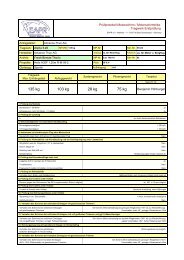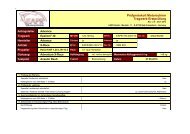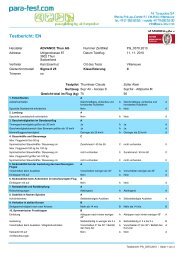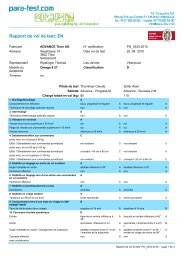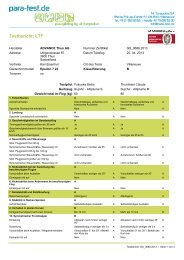User manual LIGHTNESS - Advance
User manual LIGHTNESS - Advance
User manual LIGHTNESS - Advance
- No tags were found...
Create successful ePaper yourself
Turn your PDF publications into a flip-book with our unique Google optimized e-Paper software.
<strong>LIGHTNESS</strong><strong>User</strong> <strong>manual</strong>
Edition 05-20102
ContentsThe <strong>LIGHTNESS</strong>............................................................................... 4Welcome on board!...................................................................... 4Outstanding features of the <strong>LIGHTNESS</strong>..................................... 4More important details.................................................................. 5The X-ALPS Team......................................................................... 5Safety advice.................................................................................... 6General advice about paragliding................................................ 6Handle with Care.............................................................................. 7Preparing the products.................................................................... 8Delivery......................................................................................... 8Installing the comfort foam........................................................... 9Fitting the speedbag................................................................... 10Adjusting the harness..................................................................11Fitting the speed system..............................................................17Attaching the instrument panel................................................... 18Packing and fitting the reserve................................................... 19Setting up the rucksack.............................................................. 23Using the <strong>LIGHTNESS</strong>................................................................... 25Flying with the <strong>LIGHTNESS</strong>........................................................ 25Walking with the <strong>LIGHTNESS</strong>..................................................... 25Packing the rucksack................................................................. 26Packing the back and under-seat pockets................................. 27Attaching the reserve.................................................................. 28Throwing the reserve.................................................................. 29Using the speedbag................................................................... 29Using the speed system............................................................. 29Other uses.................................................................................. 30Maintenance, repairs and service intervals................................... 32Care and maintenance............................................................... 32Check.......................................................................................... 33Repairs........................................................................................ 33Disposal...................................................................................... 33Technical details............................................................................. 34Technical Data............................................................................ 34Materials used............................................................................. 35Certification................................................................................. 35Service............................................................................................ 36ADVANCE Service Center.......................................................... 36The ADVANCE website............................................................... 36Warranty...................................................................................... 36Overview of components............................................................... 383
The <strong>LIGHTNESS</strong>Welcome on board!<strong>LIGHTNESS</strong> stands for an extremely light and very comfortable recliningharness with speedbag, together with its own lightweightrucksack. Both items go perfectly together and the resulting refinedand compact unit weighs about 3 kg. The <strong>LIGHTNESS</strong> is best suitedto cross-country Hike & Fly pilots, travellers and bivouac flyers.Outstanding features of the <strong>LIGHTNESS</strong>Tried and tested in the X-AlpsThe unique <strong>LIGHTNESS</strong> concept carries the spirit of the X-Alps withit and brings to life again the original idea of free flight - to attain thenecessary metres on foot, then make the most of their potential inflight. The ADVANCE X-Alps team have tested the <strong>LIGHTNESS</strong> productsthrough and through, and Chrigel Maurer won the hardest paragliderrace in the world with it.The harness does not have a seatboard and therefore fits the bodyperfectly. The comfortable hammock principle gives an even more directfeedback from wing to pilot. The comprehensive adjustment provisionmeans that the harness can be adapted to every individual’srequirements, and the whole body is perfectly supported. The exceptionallycompact rucksack provides excellent carrying comfort.Uncompromisingly light and well thought outThanks to the workmanship shown on the highest quality lightweightmaterials, and a convincingly simple concept, the harnesswith speedbag, front container, instrument panel and comfort foamweighs around 2.3 kg; the rucksack 700g. This means that, withoutresorting to a light wing, all your equipment can add up to only justover 10 kg - helmet and light reserve included.Top comfort – in the air and on the ground4
More important details• The harness is fitted with the proven ADVANCE two-buckle integratedchest and leg strap fastening system (equivalent to theSafe-T-System).• The adjustable-sized front container can accommodate a normalsize round reserve.• The instrument panel easily attaches to the chest strap.• An additional pocket is provided under the seat area.• The accelerate system has ball-bearing pulleys.• The harness and rucksack have the stylish ADVANCE look: classy,clear and elegant.The X-ALPS TeamChrigel Maurer won the hardest paraglider race in the world, the2009 Red Bull X-Alps from Salzburg to Monaco. He reached the finishline in less than ten days, with a lead of 180 kilometres. Heli Eichholzer(A) and Ramon Morillas (E) were the other ADVANCE team pilotsin the race. During the X-Alps all the ADVANCE pilots relied onthe <strong>LIGHTNESS</strong> products developed by Chrigel and his team. Preparationsfor the X-Alps also became the development phase of theoriginal <strong>LIGHTNESS</strong>, and Chrigel travelled countless kilometres withit in flights of up to ten hours.Chrigel’s story: In this <strong>manual</strong> Chrigel Maurer gives you backgroundinformation and useful tips about managing and usingthe <strong>LIGHTNESS</strong> harness and its rucksack.5
Safety adviceParaglider harnesses, like all commercially available reserve parachutes,are not at all suitable for free fall because of their construction.The reserve parachute and its connection to the harness are notdesigned to withstand an abrupt opening.All harness adjustments should definitely be made before flight. Correctadjustment contributes significantly to harness function, safetyand comfort in flight.The foam in the harness seat area, in this <strong>manual</strong> referred to as comfortfoam, does not provide protection from injury. When carrying outsafety training over water you should be aware that the comfort foamfloats in water and can put the pilot in a head down attitude.General advice about paraglidingFlying a paraglider calls for appropriate training and a sound knowledgeof the subject, as well as, of course, the necessary insurancecover and licence. A pilot must be able to correctly assess the weatherconditions before taking off. His or her capabilities must be adequatefor the actual paraglider.Wearing an adequate helmet, suitable boots and clothing, and carryingan emergency parachute are essential. Before every flight allitems of equipment should be checked for damage and airworthiness.A proper pre-takeoff check must also be carried out.Every pilot bears sole responsibility for all the risks associated withparticipation in the sport of paragliding, including injury and death.Neither the manufacturer nor the seller of the equipment can guaranteeor be held responsible for the pilot’s safety.6
Handle with CareADVANCE <strong>LIGHTNESS</strong> products are extremely lightly built and intendedfor specialised use. This puts particularly high demands ontheir handling and care. A committed interest in the products andtheir characteristics is essential. Because of the choice of materialsand construction rucksack and harness are much more vulnerable towear and tear from improper use than regular ADVANCE products.The <strong>LIGHTNESS</strong> products should never be dragged over the ground.All the zip fasteners are intended for light duty only and should neverbe closed under tension. Do not put pointed or sharp objects in theback pocket, the under-seat pocket or the rucksack – they coulddamage the material.Caution: ADVANCE thinks it is important that you are awareof and sympathetic to the lightweight fabrics in the<strong>LIGHTNESS</strong> products. You can enjoy the harness and rucksackfor a long time – but only if you look after them carefully.The label ‘Handle with Care’ is there to remind you that thelifespan of these products depends very much on your owncare and attention.Chrigel’s story: My equipment had to last as far as Monaco,even though I was in a hurry. I was very careful with it intraining as well as during the race. I like to compare it witha narrow wheeled racing bike, which you would never takeon a dirt road or through the woods.7
Preparing the productsDeliveryBefore the delivery of every ADVANCE product the dealer has tocheck that the delivery package is complete, and that the basic settingsare correct. The fully completed warranty form will ensure thatdefects in the product attributable to manufacturing faults are coveredby the ADVANCE warranty (see Warranty in the section “Service”).The <strong>LIGHTNESS</strong> harness is delivered with the comfort foam installedand the speedbag fitted, including the footboard and speed line. Thefour speedbag lines are already connected to the harness and thefootboard serves as a foot stirrup. All straps and speedbag lines areadjusted to their standard settings when delivered.Package ContentsThe <strong>LIGHTNESS</strong> harness package contains:• Harness and speedbag with carbon footboard• LIGHTPACK rucksack• Reserve front container with release handle and Y-connection• Instrument panel• Comfort foam for the seat area• 2 alu carabiners• Speed line with 2 brummel hooks• Booklet ‘Getting started’8
Installing the comfort foamThe comfort foam has already been installed in its pocket under theseat area at delivery.9
Fitting the speedbagThe four speedbag lines are already connected to the harness at delivery.To fit a replacement speedbag proceed as follows.Attach the speedbag Velcro to the corresponding part on the backof the harness and do up the zip fasteners completely. Hang the colouredspeedbag loops over the main carabiners.For the stirrup function: connect the lower footboard lines to the correspondinglines from the end of the seat surface of the harness usinganchor knots, and locate these on the existing overhand knots(kite knot). Connect the two upper lines from the footboard to theircounterparts running from the main suspension points.The speedbag closure system ends in a loop which is put over theplastic ball for flight. Stretching the legs into the flying position aftertakeoff automatically closes the top of the speedbag.Info: Foot support is built into the speedbag for weight-savingreasons, and is essential for supporting the pilot in the recliningposition. The <strong>LIGHTNESS</strong> harness only works with thespeedbag. The speedbag is detachable for repairs or exchange.10
Adjusting the harnessThe <strong>LIGHTNESS</strong> has many adjustment possibilities, making thestrapping system and its interactive effects reasonably complex.For an efficient and good adjustment ADVANCE recommends the<strong>LIGHTNESS</strong> ideal position, which was decided on and refined by theX-Alps team over many flights. It should provide the majority of pilotswith a comfortable and effective set up, assuming that the correctharness size has been chosen (see ‘Technical Data’ in the section“Technical details”).Start from the standard settings and make your individual adjustmentsfor the ideal position step by step along the following guidelines. Theyallow for all the important criteria, such as upper body support, evenpressure distribution, speedbag length and the most efficient speedbagangle.Caution: The adjustment of your <strong>LIGHTNESS</strong> harness is neithercomplicated nor difficult provided you keep to the recommendedstep by step procedure. ADVANCE recommendsthat you don’t deviate far from the recommended ideal position.Caution: Small changes to any of the harness straps andspeedbag lines have a large effect on the overall adjustment.Proceed with your individual settings in very small stages andalways keep the straps symmetrical, left and right, so thatyour glider will fly straight.Info: Before starting your adjustments pack the back pocket,and fit a reserve before your final assessment. You will thencome close to a realistic flying position.For reasons of weight-saving all the <strong>LIGHTNESS</strong> adjustments can onlybe made on the ground. ADVANCE therefore recommends that yougive plenty of attention to the adjustments before your first flight. Thefirst test flight should only be made in quiet weather conditions.11
625134712
1. Start with the standard settingMake sure that you start off with all the straps and the speedbaglines in their standard settings. This is the case when the free ends ofthe straps lie at the white marks. The harness is normally delivered inthis condition.To save weight the leg straps (1) and the chest strap (2) are not adjustable.The distance between the carabiners is set at a reasonable 46cm.13
2. Position your centre of gravityWith the speedbag fitted hang the <strong>LIGHTNESS</strong> up, sit in it and closethe chest strap. For the ideal centre of gravity position in the harness,and as a reference point for all further adjustments you should– first without using the support of the speedbag – slide into the seatso that your weight is supported over the main support strap (3); sothat you can balance there (centre of gravity zero position). The mainstrap is not adjustable and serves as the main support.Info: To get your centre of gravity in the right place in theharness, sit on the main support as if swinging on a trapeze.3. Setting the speedbag lengthNow you can adjust the speedbag length by means of its footboard.Do this by moving the positions of all four overhand knots symmetrically.With the correct speed bag length, both legs will be supportedon the footboard with light pressure, without effort. All four speedbaglines (4) should be under equal tension and symmetrically set.You can test this by checking the ends of the speedbag lines. If thespeedbag length is not correct there will be noticeable creases in thespeedbag.14
Further fine adjustment: By carefully altering the relativelengths of the upper and lower speedbag lines you canchange the angle of the footboard.Info: Compared with an IMPRESS harness you need noticeablyless force on the <strong>LIGHTNESS</strong> footboard to hold yourlegs level. This is because of the higher top support for thespeedbag which strongly supports your horizontal position.4. Upper body angleNow you can change the recline angle of your upper body using theback straps (5). These are mounted relatively high so as to give goodsupport to the back and take pressure off the shoulders.unaltered for the ideal position, provided that your weight is evenlydistributed, all the straps are under tension and the surface raises nopressure areas at all.Pressure areas coming from one of the four straps can be relievedby lengthening the particular strap. Or if you feel there is not enoughsupport from one of the four you can shorten it.Further fine adjustment: The seat surface straps are adjustableas you wish - but normally it should not be necessary to alterthe pre-set hammock shape of the surface.After adjusting the back straps set the shoulder straps (6) so thatthey lie loosely, or provide light support, but do not put pressure onthe shoulders.5. Fine-tuning the seat surfaceFinally check the seat surface (7), which, with its four straps plus themain support, can provide a very individual and precise fit to yourbody. Basically you can leave the pre-set adjustment of all four straps15
Checking the adjustmentsGo through the following points to check out the settings of your idealposition:- Your centre of gravity is still in the right place after all the adjustments– your weight is over the main support.- The back straps are low enough so that they do not cut into yourarmpits.- The front edge of the seat surface does not press into the backs ofyour knees.- The shoulder strap adjusters lie approximately at collarbone height.- The speedbag does not have extreme creases.Chrigel’s story: The hammock principle lets you do a lot.The ideal position should work well for the majority of pilots,and you therefore only have to adjust the small details. Forme this was the best part of the training: I used the walk upfor my conditioning training, and then would enjoy a luxurygliding flight to check the adjustments.Repeat the adjusting procedure after any or every flight, as often asnecessary.16
2Fitting the speed system1The speed line system is already attached to the footboard and fittedto the harness when delivered. To replace the speed lines proceedas follows.The speed lines are led through the red marked slots (1) at hip height,through the pulleys, and then led out through the openings in theharness side walls (2), where the lines will connect to the wing withBrummel hooks or anchor knots. The speed lines have a white sewingmark (3) on them. The standard setting is indicated when thesemarks are at carabiner top height. Inside the speedbag the end of thespeed loop fits on to the connection at the side of the footboard.Chrigel’s story: I always left my glider and harness connected.To prepare for take off I put the harness on first, then laid outthe glider. It took me several flights to adjust the speed linesbefore the X-Alps.3Caution: The speed system is correctly set up when you canuse the whole accelerate range of the glider. Make absolutelysure that the speed lines are not adjusted too short, so thatthe glider would be always accelerated in flight.17
Caution: Check that the speed lines run freely inside thespeedbag and don’t run outside the lower footboard lines,thus chafing across them.Caution: Only use the original speed lines. Different lines or aspeed bar could do a lot of damage to the speedbag.Attaching the instrument panelFix the supplied instrument panel directly on the chest strap using thethree Velcro loops. The panel has room for a GPS and/or Vario, andloops at the side for securing these devices. The panel and the instrumentscan also be secured with a line from the chest strap.Chrigel’s story: Before takeoff fold the panel and the instrumentsforward over the front container, so that the buttonsdon’t get pressed during the takeoff.Caution: For trouble-free reserve throwing only use the originalinstrument panel.18
Packing and fitting the reserveThe adjustable sized front container has space for round reserveswith volumes of 3 to 6 litres. There follow instructions for packing thereserve in the front container and connecting the reserve to the harness.For correct packing of the reserve we strongly recommend thatyou get a qualified person or your ADVANCE dealer to do it.Info: If you multiply the weight of your round reserve by 2.7you get the approximately volume in litres.Y-connection to reserve bridleConnect the supplied Y-connection to your reserve bridle with a MaillonRapide of 2400 daN minimum safe load. To prevent the webbingstraps slipping round the Maillon when the reserve opens they shouldbe stabilised on the Maillon, for example by means of rubber O rings.A direct loop-to-loop connection may only be used if it is made by aperson who has been trained and authorised by the harness manufacturer.If the loop connection is not done correctly there is a risk ofthe loops slipping on each other, causing severe heating, melting andfailure when the reserve opens.19
Connecting the release handle to the inner containerConnect the supplied release handle to the central loop of your reserveinner container.Caution: Never connect the inner container directly to thereserve.20
Packing the inner container in the front containerFirst lay the Y-connection in the front container so that each end ofthe Y-connection sticks out (left and right). Then place the inner containeron top. Make sure that the release handle connection on theinner container faces forward in the front container, and that there isthe shortest possible distance between the stowed position of the releasehandle and its connection with the inner container.Close the front container using the closure loops and stow the releasehandle in its pocket on the front of the front container. Lead thetwo yellow cables from the release handle through the closure loopsand finally into their ‘buttonholes’. The handle will then lie on the frontcontainer where it is easy to see and reach. Always make sure thatthe cables run cleanly so as to guarantee a correct deployment.21
Connecting the front container to the chest strapFix the front container on the chest strap using the three Vecro loops.The central loop makes sure that the reserve cannot slip sideways.After closing the chest strap you have to connect the reserve to theharness. Hang the ends of the Y-connection in the main carabiners(see also ‘Attaching the reserve’ in the section “Using the<strong>LIGHTNESS</strong>”).Caution: The <strong>LIGHTNESS</strong> was developed and tested with itsown reserve front container and instrument panel. ADVANCEadvises you against using a different front container because– depending on its weight and volume – throwing the reservecould be obstructed by the speedbag.22
Compatibility checkCorrect stowage of the reserve must be checked by making a test release.Hang the harness up by its carabiners and sit in it. In the flyingposition it must be possible to release the reserve without problem,and in accordance with the specifications of this <strong>manual</strong>. Make surethat the release force is not less than 4 daN and not more than 7 daN.If in doubt do not hesitate to contact a qualified person or yourADVANCE dealer. (See also ‘Attaching the reserve’ in the section“Using the <strong>LIGHTNESS</strong>”.)Caution: Make sure that the release handle action first pullsthe yellow cables, then the connection to the inner container.Caution: Before every flight check that the release handle isin its correct position and that the yellow securing cables arepositioned correctly.Setting up the rucksackThe LIGHTPACK rucksack was specially designed for the <strong>LIGHTNESS</strong>harness. It comes in one size and has room for a normal sized paraglider,the <strong>LIGHTNESS</strong> with speedbag and front reserve container,a helmet and an article of clothing. The compact geometry of the systemmeans that the rucksack can be comfortably carried by pilots ofall sizes.Side pockets provide space for small objects and for a drink system.The two lower side pockets are easy to reach while walking. Neverclose the light duty zip fasteners under tension.For good personal adjustment ADVANCE recommends that, witha fully packed rucksack, you proceed as follows, (see, Packing therucksack’ in the section “Walking with the <strong>LIGHTNESS</strong>“).Caution: The reserve can only work if the front container iscorrectly fastened to the chest strap and the reserve is connectedto the main carabiners by the Y-connection.23
31. Hip strap adjustmentThe fastened hip strap (1) of a packed rucksack should lie centredover the upper edge of your pelvis/hip bones. Pull the hip strap tightenough at this position so that, while still feeling comfortable, most ofthe rucksack weight is carried on the hip strap.2. Shoulder strap adjustment2Only pull the shoulder straps (2) in gently, so that they can be felt, butare not pressing. The more you now pull in the load adjusters (3) themore will your shoulders be unloaded. The low-mounted shouldertstraps allow for different body heights. When correctly adjustedthe shoulder straps will sit on the shoulders, without applying heavypressure.3. Carrying external load1The rucksack comes with a bungee strap which can be used for fixingwalking poles and extra clothes. You can rig it or leave it at home.24
Using the <strong>LIGHTNESS</strong>Flying with the <strong>LIGHTNESS</strong>The <strong>LIGHTNESS</strong> is normally used in a reclining position. If the harnesshas been correctly adjusted information from the wing will betransmitted directly to your mid section. Your weight will be evenlydistributed from thighs to shoulder blades. This means that pressurepoints will be avoided, blood circulation will function without problem,and you will be able to keep your concentration during long flights.The streamlined speedbag protects you from the cold, and acts as astirrup.Chrigel’s story: During the race my thoughts before a flightwere never ‘Now I’ve got to fly,’ but always ‘Now I can liedown again at last.’ The <strong>LIGHTNESS</strong> was so comfortablethat sometimes it was difficult to overcome my permanenttiredness.Chrigel’s story: You can leave the chest/leg straps permanentlyclosed, and get into and out of the harness as if itwere a climbing harness. This saves you the trouble of closingthe slide buckles and the reserve attachments. Even soyou must still check before every takeoff that the chest strapslide buckles are properly closed, that the front container isproperly attached to the chest strap and that both ends ofthe Y-connection sit correctly in the main carabiners.Walking with the <strong>LIGHTNESS</strong>This is most comfortable when the rucksack is full and under light‘full up’ tension. The volume of the rucksack is partly taken up by acorrectly folded glider, then fine tuning follows automatically with theexpansion of the harness comfort foam, which takes up the availablespace. The rucksack does not need a compression strap.Chrigel’s story: During the X-Alps I wanted to be fast, especially.That meant avoiding time-wasting situations on theground. Even on a normal tour a lot of time will be lost by regularstops. To read a map or take a drink you can slow upyour pace without having to make a stop. Always doing certainthings the same way can save a lot of time as well, andyou are less likely to forget something. Always pack yourrucksack exactly the same way, then you never have tosearch around in it.25
Packing the rucksackFold the glider to the width of the rucksack and pack it first, on theback padding. Fold the harness in half with the carabiners inside. Liethe harness – with the comfort foam on top - on the glider and slide itcompletely down in the rucksack. Compress the package so that youcan fold the rucksack cover down and easily close the zip fasteners.Finally stand the rucksack up and put the footboard into the harness.Clothing can be pushed behind the harness and the remaining spaceon top filled with helmet, instruments and supplies.Chrigel’s story: Early in the training I had to learn the lessonthat it pays to pack the rucksack carefully. After a training dayI crammed everything in my rucksack in a hurry. Not five minuteslater something sticky was running down my back, andI came to realize that Red Bull cans and climbing iron do notmake good bedfellows. It was more painful to discover thatmy glider got quite a bit of damage as well.Chrigel’s story: The packing procedure needs to be practisedand gets easier each time you do it. You can either have a bigrucksack for easy packing or a smaller, compact one for bettercarrying comfort. We went for the second option anddidn’t regret it for one second during the race. Before setting26
off you can hold the rucksack out in front of you by the shoulderstraps and press a depression in the back with yourknee. It’s important that it lies concave, or at least flat on yourback.Caution: Never drag the <strong>LIGHTNESS</strong> products over theground. Close all the zip fasteners gently and never undertension. Never pack pointed or sharp objects in the backpocket, the under-seat pocket or inside the rucksack: theycan damage the fabric.Packing the back and under-seat pocketsCareful packing of these pockets has a significant effect on flyingcomfort. Oddly shaped and hard objects can be felt through the backand surface of the harness and can affect your reclining comfort.First pack the glider inner bag at the bottom of the back pocket, thenroll the LIGHTPACK long and thin and slide it into the back pocket.The rest of the space should be used up logically and sympathetically.Put hiking poles – points upwards –, provisions and clothes in carefullyand gently, and don’t overstrain the pocket by overstuffing it!Chrigel’s story: I recommend that you always have rubbertips for your hiking poles. These will stop the sounds of thethoughtless hiker on paved roads, and guard the points whenpacked.Chrigel’s story: Storage space in the back pocket and theextra pocket under the seat is limited. To save space I alwayskeep drinks in plastic bottles and food in zip bags or in barform - not in plastic containers. When used up they need nomore space. You can carry your Camelbak in the back pocketand lead the tube out of the zip fastener.Caution: Never drag the <strong>LIGHTNESS</strong> products over theground. Close all the zip fasteners gently and never undertension. Never pack pointed or sharp objects in the backpocket, the under-seat pocket or inside the rucksack: theycan damage the fabric.Caution: Only use the original LIGHTPACK with the <strong>LIGHTNESS</strong>harness. An EASYPACK would be too big for the back pocket,and could affect comfort in flight.Info: The extra under-seat pocket is the perfect place – nearyour centre of gravity – for carrying additional items.27
Attaching the reserveBefore every flight the reserve front container must be connected tothe main carabiners using the two ends of the Y-connection, in sucha way that they do cannot get in the way of the carabiner gates. Youmust also make sure that the front container is firmly attached to thechest strap by means of the three Velcro loops. (See also ‘Connectingthe front container to the chest strap’ in the section “Preparingthe products”)Caution: Always hang the ends of the Y-connection in themain carabiners first; then the paraglider risers - so that theY-connection does not get in the way of the carabiner gates.28
Throwing the reserveIn an emergency free the release handle with a strong pull, and throwit (together with the inner container) into free airspace. The lines willpay out and the inner container open. The canopy will pull out, extendand fill.To save weight the reserve supports the <strong>LIGHTNESS</strong> harness byits main carabiners. This makes it difficult for the pilot to get into anupright position for landing, and you have to do this actively. Stopthe glider from flying by pulling hard on the B or C risers, so that itdoesn’t interfere with the reserve by pulling against it (to the oppositeside = scissoring).Caution: As usual with front containers paraglider line twistscan make it difficult to reach the release handle.Using the speedbagAfter liftoff stay leaning forward, pick up the speedbag (which will behanging slightly behind) with a foot, and you can now push yourselfinto a comfortable reclining position with its help. The top of the speedbagcloses automatically when the legs stretch the footboard out.For landing take both feet out of the speedbag in good time and takeup your upright position. You should always be standing up for landing– so as not to damage yourself or your equipment.Chrigel’s story: The speedbag length is very critical for a trulycomfortable flying position. This length can vary – even dependingon your shoes – and should be adjusted for everysituation.Chrigel’s story: Always bear in mind that your own attitudecan affect your safety much more than will your equipment.So, for takeoffs and landings stay or get into your upright positionfor a longer rather than shorter time – this will avoid hittingthe ground with your backside. Otherwise you can damageyourself – and your harness.Using the speed systemThe speed loop in the speedbag is always easy to reach because it istensioned forward by bungee. One leg should stay stretched forwardon the footboard to keep the speedbag under tension. When the secondstep is required, the foot on the first speed step automaticallygoes to the footboard and takes over this job. Using the speed systemwith one foot like this means you can feel the wing better and ac-29
Maintenance, repairs and serviceintervalsCare and maintenanceIn the choice of materials special attention was given to savingweight. The harness was still designed for high loading, but not forextreme demands. The life of the harness depends, to a great extent,on the way it’s looked after by its users, and we recommend that theharness is routinely inspected for signs of wear, damaged seams andwebbing, and that damaged parts are replaced. It is especially importantto note that any suspected damage should be immediatelytaken to an authorised workshop for repair.Caution: Do not modify your harness, and never fly with aharness that has any kind of damage to its webbing.It is recommended that the harness is completely checked at leastonce a year: this must include the condition of the seams and webbingparts, and the operation of the buckles. Don’t forget the regularairing and repacking of your reserve parachute. If your reserve hasbeen thrown in an emergency your harness should also be checkedby the manufacturer or an authorised service centre.Ultraviolet light, heat, humidity, salt water, aggressive cleaningagents, unsuitable storage as well as physical abuse (dragging overthe ground) speeds up the ageing process.The life of your harness can be greatly extended if you observe thefollowing points:• Let a wet or damp harness dry completely at room temperature, oroutside in the shade. Always repack your (dry) reserve.• If your harness gets wet with sea water rinse it thoroughly in freshwater. Always repack your (dry) reserve.• Only clean your harness with fresh water, and a little neutral soap ifnecessary. Never use solvents.• Check the harness connection and reserve bridle after every reservedeployment.• A qualified person must check the harness after any very highloading (e.g. heavy crash).• Regularly inspect the harness for damaged seams and webbing.In particular check the harness connection/reserve bridle and theseams near the main carabiners.• Don’t subject the harness to extremes of temperature and makesure it gets adequate ventilation, to prevent condensation forming.• Do not leave the harness in the sun (without good reason) beforeand after flying.Most reserve parachute manufacturers recommend an inspectionand repacking every six months, so as to guarantee a fast and routineopening every time. If the reserve gets wet, damp or overheated32
it must unquestionably be repacked. We strongly recommend thatyou let a qualified person pack your reserve. In addition, ADVANCEalso strongly recommends that you regularly check the harness tosee that the yellow cables run through their loops properly. Then youcan be sure they will easily release the reserve when required.The comfort foam doesn’t need special attention, but it should stillbe inspected for possible damage after a crash. If the outer coveris damaged this item must be replaced. The harness should not bestored close to corrosive substances, or left in a hot place for a longtime.CheckAll your equipment must be given a check every 24 months (2 years).With intensive use (more than 150 flying hours per year) an annualcheck is needed, after the first check. The check includes a visual assessmentof the material, webbing parts and connections, the mostimportant sewing as well as the suspension carabiners. All parts areinspected for tears, kinks, frayed seams, general damage and evidenceof serious misuse. Finally the overall condition of the harness is ratedand recorded in the service handbook.You can find additional information about the check in this <strong>manual</strong> inthe section “Service”, or at www.advance.ch.RepairsAs a general rule you should not attempt to repair a harness yourself.The various seams are made with great precision, and, for this reason,only the manufacturer or an authorised service centre may makerepairs using original materials.DisposalEnvironmental protection plays an important role in the selection ofmaterials and the manufacture of an ADVANCE product. We use onlynon-toxic materials that are subjected to continuous quality and environmentalimpact assessments. When your harness reaches theend of its useful life in a number of years’ time, please remove all metalparts and dispose of the rest of the harness in a waste incinerationplant.33
Technical detailsTechnical Data<strong>LIGHTNESS</strong> S M LPilot height cm 155 -170 165 - 185 180 - 200Seat area width * cm N. A. N. A. N. A.Carabiner height * cm N. A. N. A. N. A.Chest strap width cm 46 46 46Harness weight incl. comfort foam and alucarabiners (2)kg 1.49 1.57 1.65Speedbag weight with footboard kg 0.52 0.55 0.61Front container with release handle andY-connectionkg 0.18 0.18 0.18Total weight of harness kg 2.2 2.3 2.4Volume of rucksack lt 75Weight of rucksack kg 0.66* Because of the hammock system the harness takes on the body shape of the pilot. The width of the seat area therefore varies with the pilot, as does the height of the suspension points(carabiners).34
Materials usedWe routinely inspect and test our base materials many times overduring the manufacturing process. Like all ADVANCE products the<strong>LIGHTNESS</strong> is designed and produced as a result of the latest developmentsand knowledge. We have chosen all the materials very carefully,under conditions of the strictest quality control.Outer coveringNylon Ripstop 70D PU 3Inner coveringNylon Oxford 210DY-connectionDyneema 10 mmRucksackNylon Ripstop 70D PU 3 / Nylon Oxford 210 D, PU2CertificationThe <strong>LIGHTNESS</strong> has been tested and approved in accordance withthe LTF and DIN EN-Norm 1651 requirements at 110 kg operatingweight. The comfort foam does not have certification.ServiceSpeedbagNylon Oxford 210D PU 2StrapsPolyester 25 mm 800 kgChest strap bucklesAluminium slide buckles35
ServiceADVANCE Service CentresADVANCE operates two company-owned service centres that carryout checks and repairs of all types. The workshops based in Switzerlandand France are official maintenance operations, certified bythe DHV, which possess many years’ experience and in-depth product-specificexpertise. The ADVANCE worldwide service network includesother authorised service centres that provide the same services.All service facilities use original ADVANCE materials exclusively.You can find all information on checks and repairs and the relevantaddresses at www.advance.ch.The ADVANCE websiteAt www.advance.ch you will find detailed information about ADVANCEand its products as well as useful addresses, which you can contactif you have any questions.On the www.advance.ch website you will be able to:• complete the warranty card online up to 10 days after purchaseof the glider, enabling you to enjoy the full benefits of the ADVANCEwarranty• find out about new safety-related knowledge and advice concerningADVANCE products• download an application form in PDF format which you can usewhen sending your glider in for a check at ADVANCE• find an answer to a burning question among the FAQs(Frequently Asked Questions)• subscribe to the ADVANCE Newsletter so that you will be regularlyinformed by e-mail about news and products.It is well worth visiting the ADVANCE website regularly because therange of services offered is continually being expanded.WarrantyIn order to enjoy the full benefits of the ADVANCE warranty, you arerequested to complete the relevant form on the website in the «Warranty»section within 10 days of purchase.As part of the ADVANCE warranty, we undertake to rectify any defectsin our products that are attributable to manufacturing faults. To makea claim on the warranty notify ADVANCE immediately if a defect isdiscovered, and send the defective product in for inspection. Themanufacturer will then decide how a possible manufacturing faultis to be rectified (repair, replacement of parts or replacement of theproduct). This warranty is valid for three years from the date of purchaseof the product.36
The ADVANCE warranty does not cover any claim other than thoseindicated above. Claims in respect of damage resulting from carelessor incorrect use of the product (e.g. inadequate maintenance, unsuitablestorage, overloading, exposure to extreme temperatures, etc.)are expressly excluded. The same applies to damage attributable toan accident or normal wear and tear.37
Overview of components1 Main suspension points2 Main support3 Shoulder straps4 Back straps5 Chest strap6 Two-buckle clip-in system7 Leg straps8 Seat surface straps9 Seat surface10 Speedbag11 Speedbag lines / Integrated stirrup12 Speed line13 Back compartment14 Comfort foam15 Speedbag closure system38
3165471381011212914151539
advance thun agseestrasse 14ch 3602 thunfon +41 33 225 70 10fax +41 33 225 70 11www.advance.chinfo@advance.ch



